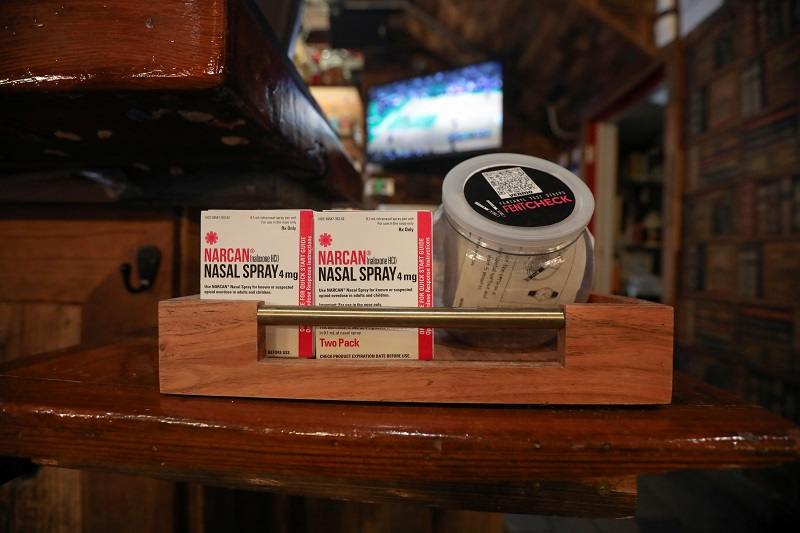
Fentanyl test strips in a container and Narcan are seen at The Legionnaire bar in Oakland, California, U.S., March 3, 2022. Picture taken March 3, 2022.
13:33 JST, December 13, 2022
Fentanyl, a powerful painkiller developed nearly 60 years ago, is at the center of the deadliest drug epidemic in American history. More people have died of synthetic-opioid overdoses than the number of U.S. military personnel killed during the Vietnam, Iraq and Afghanistan wars combined. Fentanyl is now the leading cause of death for Americans ages 18 to 49, according to a Washington Post analysis of death data for 2021 from the Centers for Disease Control and Prevention.
One of the greatest dangers of fentanyl is its potency. Deaths attributed to the drug began to climb in 2013, when traffickers began mixing illicit fentanyl with other drugs including heroin, counterfeit pain pills and cocaine. In some instances, drug users have no idea that fentanyl has been added.
Here is what you need to know.
What is fentanyl?
Fentanyl is a man-made opioid used to manage severe pain. It is typically administered to cancer or surgery patients. The drug was created by a Belgian physician in 1960 and approved for use as an anesthetic in 1972. Pharmaceutical fentanyl is reserved for patients who experience powerful pain that requires a stronger opioid dosage, and most patients who receive fentanyl have already been taking some type of opioid.
Fentanyl is much more powerful than morphine or heroin. Fentanyl can produce feelings of euphoria similar to heroin. The drug can also cause reduced blood pressure, sedation, dizziness and respiratory depression, according to the Drug Enforcement Administration.
What makes fentanyl so deadly?
It takes about 2 milligrams of fentanyl to overdose. The opioid is 50 times more potent than heroin.
Drug dealers have been selling straight fentanyl, which is more profitable for them, but fentanyl also can be combined with street drugs such as heroin and cocaine. Users are at a higher risk of dying as they take pills without knowing they contain a lethal dose of fentanyl or any fentanyl at all.
Fentanyl analogues – or chemical variations of the drug – pose a major problem to law enforcement. Chemists can tweak the analogues to make versions of fentanyl that are not banned by law. Thus begins a game of cat and mouse: Federal officials race to identify and ban the analogues while chemists continue to make new ones.
What is being done to address the crisis?
Many police officers and paramedics carry naloxone, a drug that can help reverse an overdose. Naloxone can be injected into the body or be administered as a nasal spray. It works as an antidote, blocking the effects of opioids and helping restore breathing.
It can also be purchased without a prescription at some pharmacies.
In recent years, the Centers for Disease Control and Prevention, the Food and Drug Administration and the U.S. surgeon general have called for expanded access to naloxone for first responders and community organizations. In one study, opioid deaths in 19 Massachusetts communities fell by 11 percent after the state implemented a naloxone distribution and education program.
But federal officials admit that access to naloxone is uneven across the country. The Biden administration has announced spending and a multipart strategy directed at fighting the growing opioid crisis through harm reduction and drug-use-prevention measures.
U.S. border authorities are overwhelmed by the volume of fentanyl entering the country. Congress commissioned an extensive report, which determined that progress against fentanyl would be achieved only by pairing enforcement with a reduction in U.S. demand.
What does fentanyl look like?
Pharmaceutical fentanyl comes in tablets, patches, sprays and lollipop-like lozenges.
Illicit fentanyl is a white, powdery substance and can be pressed into counterfeit prescription pills.
Multicolored “rainbow” tablets have been seized, which narcotics agents think are meant to signal to users that the multicolored pills contain fentanyl.
Does fentanyl have other names?
Fentanyl can be called many street names, including Apace, China Girl, China Town, China White, Dance Fever, Goodfellas, Great Bear, He-Man, Poison, and Tango and Cash, according to the DEA.
What are the signs of a fentanyl overdose? What should you do if you suspect an overdose?
Symptoms of a fentanyl overdose include cold and clammy skin, unconsciousness or near-unconsciousness, blue discoloration of the skin, very small pupils, coma and respiratory failure.
If you suspect someone is experiencing an overdose, the CDC recommends the following:
– Call 911 immediately.
– Administer naloxone, if it is available.
– Try to keep the person awake and breathing.
– Lay the person on their side to prevent choking.
– Stay with him or her until emergency workers arrive.
Can fentanyl be absorbed into the skin?
This is a common myth and should be clarified. The risk to emergency responders is “extremely low,” according to the American College of Medical Toxicology (ACMT) and the American Academy of Clinical Toxicology (AACT).
Their current position states: “To date, we have not seen reports of emergency responders developing signs or symptoms consistent with opioid toxicity from incidental contact with opioids.”
Andrew Stolbach, one of the lead authors of the ACMT statement and a Johns Hopkins medical toxicologist and emergency physician, said fentanyl does not pose a risk to first responders who take basic precautions.
“Fentanyl is absorbed very poorly through the skin,” Stolbach said. “For routine precautions, simple nitrile gloves are more than sufficient. If powder does get on the skin, washing it off with water is sufficient.”
Michael J. Moss, a toxicologist and the Utah Poison Control Center’s medical director, led the writing of the ACMT and AACT’s position statement and said first responders or family members shouldn’t assume that just being around fentanyl will make them sick.
“Fentanyl is potent, though it is very unlikely – extremely unlikely – that anyone would be exposed from incidental contact, and we don’t want people to be afraid to take care of someone who might have overdosed because they think fentanyl could be around,” Moss said.
What is naloxone? Is it available over the counter?
Naloxone is a prescription medication but is available for purchase without a prescription through some pharmacies and community organizations. Naloxone is available for purchase without a prescription at CVS pharmacies in all 50 states, the District of Columbia and Puerto Rico. Walgreens also offers naloxone without a prescription.
The medication works to rapidly reverse or block the effects of opioids and can be administered via a nasal spray or through an auto-injector. Naloxone will work for only 30 to 90 minutes, so a person may need multiple doses or still feel the effects of an overdose after the naloxone wears off.
How many people have died of fentanyl overdoses?
The United States has experienced three major waves of opioid deaths. They began in the late 1990s, when Americans increasingly began to overdose on prescription painkillers, such as OxyContin and Vicodin. The next wave began in 2010, when addicts turned to heroin as supplies of prescription opioids dried up. In 2013, fentanyl overdoses started to skyrocket.
In 2016, fentanyl surpassed heroin as the opioid most responsible for overdose deaths. That year, 19,720 people died of overdoses related to synthetic opioids, most of those cases involving fentanyl. In 2021, synthetic-opioid overdoses rose to 71,238.
Which parts of the country are most affected?
Some of the highest death tolls are concentrated in the Northeast and Midwest.
The first signs were detected at the state morgue in spring 2013 in Rhode Island with a sudden increase in overdose deaths. In 2021, the highest rates of overdose deaths were recorded in West Virginia, D.C., Tennessee and Kentucky.
Where does illicit fentanyl come from?
Fentanyl manufactured in clandestine labs has been traced to Mexico and China, according to the DEA.
Some of the illicit fentanyl made in Chinese labs was sent to the United States in small packages through the U.S. postal system or overnight shipping companies, making it difficult to detect. The Department of Justice announced its first indictment against Chinese fentanyl manufacturers in October 2017, when officials in North Dakota charged two Chinese nationals with selling fentanyl over the internet. The department alleged that one of the suspects operated at least two chemical plants capable of producing tons of fentanyl and fentanyl analogues.
It is also smuggled into the country across the country’s land borders, especially in California and Arizona. Fentanyl seizures at the southern border have skyrocketed since 2016. Traffickers use the U.S. interstate system to reach wholesale markets in Los Angeles, Las Vegas, Chicago and East Coast cities, where street-level drug dealers take over.
Who manufactures fentanyl?
It is important to note that there are two types of fentanyl: medicinal and illicit. The Belgian physician Paul Janssen developed fentanyl in a lab in 1960, and the FDA approved it in 1968. When fentanyl was created, it was the most potent opioid in the world. It mimics the effects of opioids including opium and morphine.
Medicinal fentanyl is prescribed to patients who experience extreme pain. It is distributed by pharmaceutical companies under names including Actiq, Duragesic and Sublimaze. Janssen’s team intended for it to be used as a painkiller that can be administered through an IV. Now, the drug is available in a pill, spray or patch.
Illicit fentanyl is created by illegal labs or drug traffickers. Fentanyl is a synthetic, man-made opioid – no plant material is required to produce it. It can be manufactured in a small lab, with relatively accessible chemicals, in just a few days. The DEA thinks that most synthetic opioids found in the United States are produced abroad.
"News Services" POPULAR ARTICLE
-

American Playwright Jeremy O. Harris Arrested in Japan on Alleged Drug Smuggling
-

Taiwan President Shows Support for Japan in China Dispute with Sushi Lunch
-

Japan Trying to Revive Wartime Militarism with Its Taiwan Comments, China’s Top Paper Says
-

Japan’s Nikkei Stock Average as JGB Yields, Yen Rise on Rate-Hike Bets
-

Japan’s Nikkei Stock Average Licks Wounds after Selloff Sparked by BOJ Hike Bets (UPDATE 1)
JN ACCESS RANKING
-

Govt Plans to Urge Municipalities to Help Residents Cope with Rising Prices
-

Essential Services Shortage to Hit Japan’s GDP By Up to ¥76 Tril. By 2040
-

Japan’s Hopes for Seafood Exports Shot Down in China Spat
-

Japan Prime Minister Takaichi Vows to Have Country Exit Deflation, Closely Monitor Economic Indicators
-

Japan to Charge Foreigners More for Residence Permits, Looking to Align with Western Countries


























